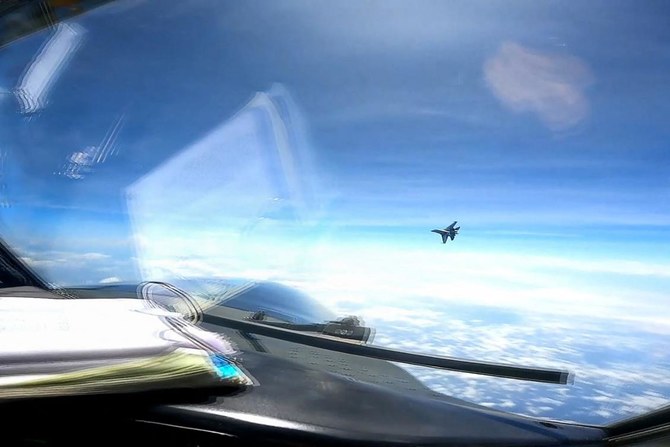Latest clash between Chinese and US military aircraft in South China Sea adds to escalating tensions.
Amidst escalating tensions between Washington and Beijing, China has placed blame on the United States for a recent incident over the South China Sea. A Chinese plane crossed paths with an American surveillance aircraft, prompting strong reactions from both sides. In response, China’s foreign ministry spokesperson, Mao Ning, accused the US of continuously conducting close surveillance on China, posing a threat to its national sovereignty and security. Mao emphasized that such provocative and dangerous activities are the root cause of security concerns at sea, pledging China’s unwavering commitment to safeguarding its sovereignty and security.
The US military, on the other hand, characterized the Chinese fighter pilot’s actions as an unnecessarily aggressive maneuver. Video evidence released by the US military depicts the Chinese fighter jet crossing in front of the American aircraft, causing turbulence that visibly impacted the shaken surveillance plane. According to the Indo-Pacific Command, the Chinese plane flew directly in front of the American aircraft’s nose at a distance of 400 feet (122 meters), forcing the US aircraft to endure its wake turbulence. The US military clarified that the RC-135 was conducting routine operations in international airspace over the South China Sea, fully compliant with international law.
This incident occurs within a backdrop of strained relations between the US and China, with contentious issues such as Taiwan, which China considers its territory, and the shooting down of an alleged Chinese spy balloon over US territory earlier this year.
Perilous airborne intercepts
The Pentagon has highlighted an ongoing pattern of risky aerial intercepts and confrontations at sea by Chinese aircraft and ships, which pose the potential for unsafe incidents or miscalculations. A senior US defense official expressed alarm over the increasing frequency of such incidents. This announcement came shortly after China declined an invitation for Secretary of Defense Lloyd Austin to meet his Chinese counterpart in Singapore, further straining communication channels.
US Secretary of State Antony Blinken emphasized the importance of establishing regular and open lines of communication between defense ministers, particularly in light of the recent fighter jet incident. Blinken called on Beijing to agree to enhanced communication and address mutual concerns. However, Beijing responded by holding the US entirely responsible for the current difficulties in military exchanges, accusing the US of creating obstacles and undermining trust.
While efforts are underway to lower tensions, with meetings between US National Security Adviser Jake Sullivan and top Chinese diplomat Wang Yi, as well as President Joe Biden expressing hope for improved relations, the US continues to bolster alliances and partnerships in Asia to counter perceived assertive moves by China. China’s People’s Liberation Army, the world’s largest standing military, frequently engages in confrontations with military aircraft from the US and its allies in the South and East China Seas, as well as the Taiwan Strait.
The historical context reminds us of the 2001 in-air collision between a Chinese fighter and a US Navy surveillance plane, resulting in the loss of the Chinese aircraft and the death of the pilot. This incident serves as a stark reminder of the potential risks involved in such encounters.
An analysis of the news
The news highlights China’s accusation against the United States of inciting a reckless air confrontation. This incident occurred in the context of ongoing tensions between the two countries and took place over the South China Sea. China alleges that a US aircraft engaged in provocative and dangerous behavior by crossing paths with a Chinese plane. The Chinese foreign ministry spokeswoman, Mao Ning, asserted that the US’s continuous surveillance activities in close proximity to China’s territory infringe upon its national sovereignty and security.
China emphasizes that such actions by the US are the primary cause of security concerns in the region. Mao Ning further asserts that China will take all necessary steps to protect its sovereignty and security in response to such provocations. On the other hand, the US military describes the Chinese fighter pilot’s actions as unnecessarily aggressive and highlights the potential risks associated with such maneuvers.
The incident further escalates the already strained relationship between China and the United States. It comes amidst broader geopolitical tensions and disputes over issues like Taiwan and alleged espionage activities. The confrontation highlights the deep-rooted distrust and conflicting interests between the two nations. Efforts to mitigate these tensions, such as inviting high-level meetings between defense officials, have been met with refusals and obstacles.
The implications of this incident are significant as it adds to a series of confrontations between the Chinese and US militaries. Such encounters have the potential to lead to unintended incidents or miscalculations, heightening the risk of a broader conflict. The incident underscores the importance of open lines of communication and de-escalation measures between the two countries to prevent further tensions and maintain regional stability.
SOURCE: AL JAZEERA


